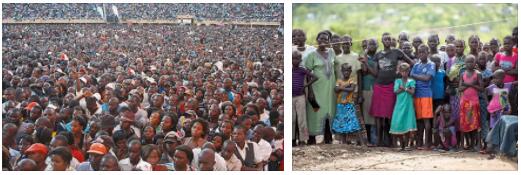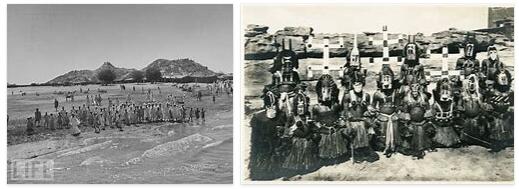Uganda Population
In Uganda there are remains of pygmy populations to which the Bantu populations, which constitute the largest group, have overlapped. The northern part is occupied by Nilotic tribes; Bantu and Nilotics have been influenced by Hamite tribes, warriors and rulers.
Agriculture and hunting occupy a preponderant part in the economy of the peoples of Uganda; nomadic shepherds are above all the Kitara and Karamojo; the latter feed essentially on milk and blood.
With the exception of the Banyankole and Bakitara who formed despotic monarchies, ruled by absolute kings, the tribes are divided into great families each of which is ruled by a chief whose power is moderated by the elders; on the contrary, the Bagesu are ruled only by the old men of the village. The lack of political unity is the cause of the weakness of these populations. Almost everywhere kings and chiefs have a religious and magical character, are related to the vegetation and are linked to the type of the sacred king, a rather widespread institution in Africa, which reached one of the highest expressions in ancient Egypt: among the Basoga the head of the district is responsible for the rain and is believed to have the power to send it or to provide good weather; the king of the Bakitara can also marry his sisters, as long as they have a different mother, while for all the other members of the tribe there is exogamy and relations between people of the same clan are considered guilty.
The Roscoe informs that several tribes are divided into clans with their own totem regulating kinship; each totem has particular prohibitions of which the natives do not know how to explain the origin. JH Driberg also tends to see totemism in the Langos, while among the Acoli only a trace of it has been found and not a sociological system that can be said to be organized on totemism. Many tribes practice initiation.
According to Country Center, Monogamy was the basis of the Banyankole and Bakitara family until a few decades ago and some social categories still observe it; polygamy was allowed only in case of sterility and among the Bakitara only the king normally took more than one wife, even if the first was not sterile, but the kinship between the members of the same clan, who are called brothers, is felt so strong that it does not consider adultery if one of them has intercourse with the wife of the others. The Wahima also practice polyandry. Polygamy, on the other hand, is commonly accepted among the Nilotics of Uganda; however, even among these tribes the number of wives was once forcibly limited, given the very strong dowry required for marriage: among the Acoli, for example, in ancient times the woman was sometimes paid even with eighty cows.
There is the revenge of blood following a murder, which can only be repaired by paying one or two of the killer’s daughters to the family of the murdered.
All the tribes explored with care are monotheistic because, while paying worship to a number of spirits and deified objects, they subordinate everything to a supreme being, against whose will no one can act, not even the spirits and the sorcerer. To the supreme being are direct prayers – only among the Acoli it was possible to collect a few hundred – and sometimes even sacrifices. The sacrifice of first fruits is also documented in Uganda, but it is still uncertain whether it is directed to the Supreme Being or to the dead, who receive a great cult among all populations.
Diseases, especially internal ones, are attributed to spirits or magic and it is the sorcerer’s job to find the cause; the ceremonies for obtaining rain, which belongs to the Supreme Being, are among the most important, whoever performs them is subject to certain taboos and among the Bakitara is directly responsible to the king. The serpent receives worship especially among the Bantu peoples and certain rivers are sacred to it; much venerated are the horns of animals killed in hunting and the mountains. The latter are considered the seat of spirits. Human sacrifice was not practiced frequently, but is documented among different tribes; however, only the Bagesu have cannibalistic ritual meals.
Some populations bury the dead, others abandon them outside the village to feed the hyenas.



